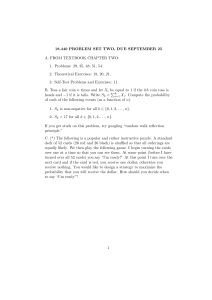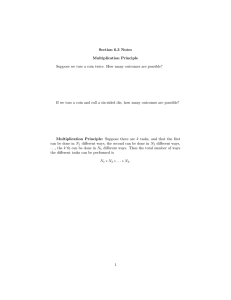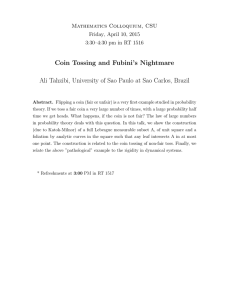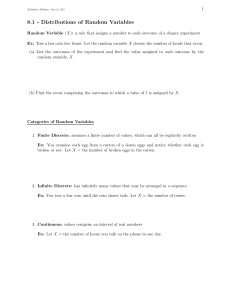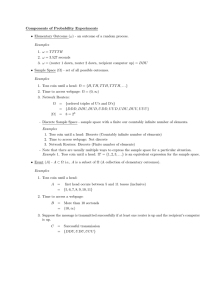Review Probability Axioms A and B
advertisement
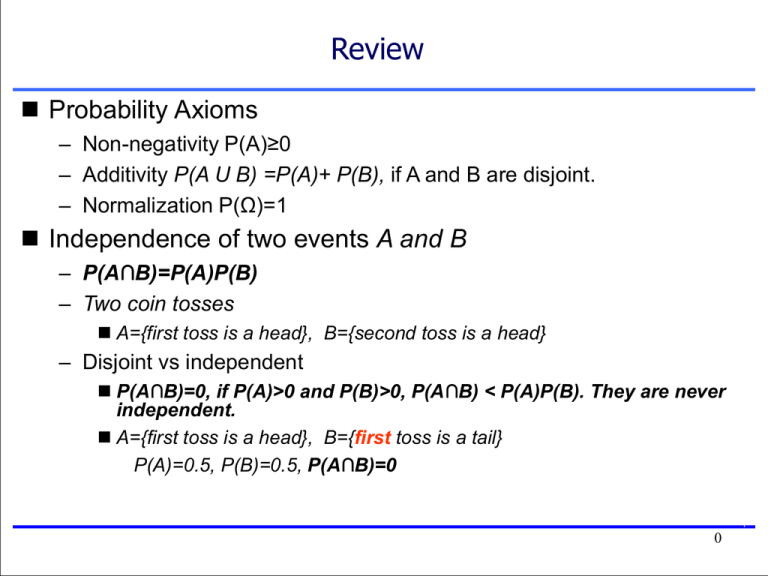
Review
Probability Axioms
– Non-negativity P(A)≥0
– Additivity P(A U B) =P(A)+ P(B), if A and B are disjoint.
– Normalization P(Ω)=1
Independence of two events A and B
– P(A∩B)=P(A)P(B)
– Two coin tosses
A={first toss is a head}, B={second toss is a head}
– Disjoint vs independent
P(A∩B)=0, if P(A)>0 and P(B)>0, P(A∩B) < P(A)P(B). They are never
independent.
A={first toss is a head}, B={first toss is a tail}
P(A)=0.5, P(B)=0.5, P(A∩B)=0
0
0
1.3 Conditional Probability
1.4 Total Probability Theorem and Bayes’ Rule
1
1
Conditional Probability
A way to reason about the outcome given partial information
Example1
– To toss a fair coin 100 times, what’s the probability that the first toss
was a head?
Fair coin
1/2
– To toss a fair coin 100 times, if 99 tails come up, what’s the probability
that the first toss was a head?
Very small?
Example2
– A fair coin and an unfair coin (1/4 tail, 3/4 head)
The first toss is fair, if the outcome is a head, use the fair coin for the 2nd
toss, if the outcome is a tail, use the unfair coin for the 2nd toss.
What’s the probability that the 2nd toss was a tail?
– ½x½ + ½x¼ = 0.375
What’s the probability that the 2nd toss was a tail if we know that the first
toss was a tail?
– 1/4
2
2
Conditional Probability
Definition of a conditional probability
– The probability of event A given event B (P(B)>0 )
– P(A|B)=P(A) if A and B are
independent
A new probability law (recall the definition of probability laws)
–
3
3
Conditional Probability
Examples
– Two rolls of a die, what’s the probability that the first roll was a 1?
– Fair dice
1/6
– Two rolls of a die, the sum of the two rolls is 6, what’s the probability
that the first roll was a 1?
B: (1,5) (2,4) (3,3) (4,2) (5,1) , A and B: (1,5)
P(A|B)= (1/36)/(5/36)=1/5
– Two rolls of a die, the sum of the two rolls is 6, what’s the probability
that the first roll was EVEN?
B: (1,5) (2,4) (3,3) (4,2) (5,1) , A and B: (2,4) (4,2)
P(A|B)= (2/36)/(5/36)=2/5
4
4
Conditional Probability
The new universe is B
P(A1)> P(A2), does it mean that P(A1|B)> P(A2|B)?
No!
– An Example: Two rolls of a die
B: the sum of the two rolls is 4, (1,3) (2,2) (3,1)
A1: the first roll was 1 or 2
A2: the first roll was 3, 4, 5 or 6
– P(A1 )=1/3
P(A2)=2/3
– P(A1 ∩ B) = 2/36 = 1/18
– P(A1 | B)= (1/18)/(1/12) =2/3
P(B)= 3/36 =1/12
P(A2 ∩ B) = 1/36
P(A2 | B)= (1/36)/(1/12) =1/3
5
5
Conditional Probability
The Chain Rule
6
6
Conditional Independence
Conditional independence, A and C are independent
conditional on B, P(B)>0
P(A∩C|B)=P(A|B) P(C|B)
Example (conditional independence ≠ independence): unfair
coins, coin 1- (0.9 head, 0.1 tail) coin 2- (0.1 head, 0.9 tail),
coin 3 is fair.
– Toss coin 3 first. If it’s head, toss coin 1 twice. If it’s tail, toss coin 2
twice.
– A= X H X, the event that the 2nd toss is a head
– C= X X H, the event that the 3rd toss is a head
– B= H X X, the event that the first toss is a head
7
7
Total Probability Theorem
A1 , A2, … An be a partition of Ω
– Recall the definition of a partition
Total
Probability Theorem
8
8
Total Probability Theorem
An example
– A fair coin and an unfair coin (1/4 tail, 3/4 head)
The first toss is fair, if the outcome is a head, use the fair coin for the 2nd
and 3rd toss, if the outcome is a tail, use the unfair coin.
– B={ the 2nd and 3rd tosses are both tails}
– A1 ={the first toss is an head}, A2 ={the first toss is a tail}. A1 and A2 is a
partition of the universe.. P(A1)=P(A2)= 1/2
– P(B|A1 )= 1/4, P(B|A2 )= 1/16
9
9
Bayes’ Rule
A1 , A2, … An be a partition of Ω
Bayes’ Rule
10
10
Bayes’ Rule
An Example
Question:
– How likely is there a tumor given that a shade is observed?
– P(A2 |B)
11
11
Bayes’ Rule
Bayes’ Rule from scratch
12
12
Sending a bit through a noisy channel
Sender has a bit b- either 0 or 1 with equal probability to send
to the receiver
– p=0.1
– Question1: if the sender sends b once, and the receiver receives 1,
what can the receiver say about b?
– Question2: if the sender sends b 3 times, and the receiver receives
1,1,1 what can the receiver say about b?
– Question3: if the sender sends b 3 times, and the receiver receives
1,0,1 what can the receiver say about b?
13
13
